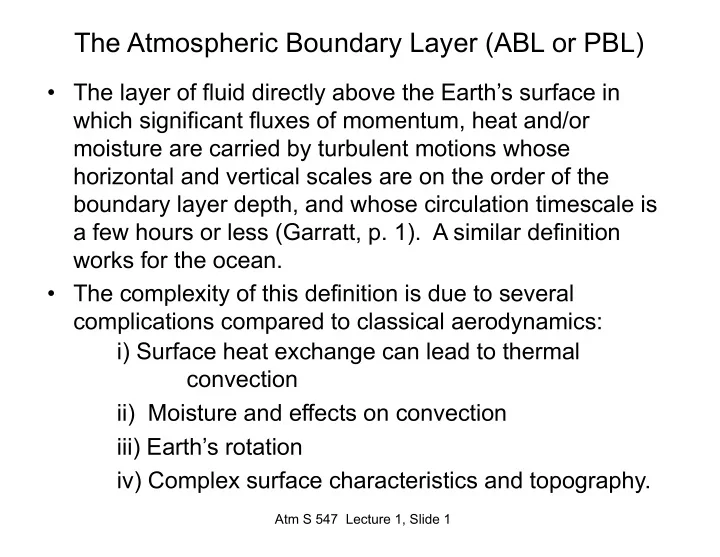

The Atmospheric Boundary Layer (ABL or PBL) • The layer of fluid directly above the Earth’s surface in which significant fluxes of momentum, heat and/or moisture are carried by turbulent motions whose horizontal and vertical scales are on the order of the boundary layer depth, and whose circulation timescale is a few hours or less (Garratt, p. 1). A similar definition works for the ocean. • The complexity of this definition is due to several complications compared to classical aerodynamics: i) Surface heat exchange can lead to thermal convection ii) Moisture and effects on convection iii) Earth’s rotation iv) Complex surface characteristics and topography. Atm S 547 Lecture 1, Slide 1
Sublayers of the atmospheric boundary layer Atm S 547 Lecture 1, Slide 2
Applications and Relevance of BLM i) Climate simulation and NWP ii) Air Pollution and Urban Meteorology iii) Agricultural meteorology iv) Aviation v) Remote Sensing vi) Military Atm S 547 Lecture 1, Slide 3
History of Boundary-Layer Meteorology 1900 – 1910 Development of laminar boundary layer theory for aerodynamics, starting with a seminal paper of Prandtl (1904). Ekman (1905,1906) develops his theory of laminar Ekman layer. 1910 – 1940 Taylor develops basic methods for examining and understanding turbulent mixing Mixing length theory, eddy diffusivity - von Karman, Prandtl, Lettau 1940 – 1950 Kolmogorov (1941) similarity theory of turbulence 1950 – 1960 Buoyancy effects on surface layer (Monin and Obuhkov, 1954). Early field experiments (e. g. Great Plains Expt. of 1953) capable of accurate direct turbulent flux measurements 1960 – 1970 The Golden Age of BLM. Accurate observations of a variety of boundary layer types, including convective, stable and trade- cumulus. Verification/calibration of surface similarity theory. 1970 – 1980 Introduction of resolved 3D computer modelling of BL turbulence (large-eddy simulation or LES). Application of higher-order turbulence closure theory. Atm S 547 Lecture 1, Slide 4
History continued... 1980 - 1990 Major field efforts in stratocumulus-topped boundary layers (FIRE, 1987) and land-surface, vegetation parameterization. Mesoscale modeling. 1990 - 2000 New Technologies New surface remote sensing tools (lidar, cloud radar) and extensive space-based coverage of surface characteristics; LES as a tool for improving parameterizations and bridging to observations. Boundary layer - deep convection interactions (e. g. TOGA-COARE, 1992) 2000-2020 PBL processes in earth and human system models Coupled ocean-atmosphere-ice-biosphere models create new requirements for BL parameterizations, e. g. better treatment of surface wind stress, vegetated surfaces, BL clouds and aerosols. More accurate BL simulation needed for modelling air flow around buildings and urban areas, air pollution modeling near complex terrain. Ensemble data assimilation enables better use of near-surface and boundary-layer data over land surfaces Atm S 547 Lecture 1, Slide 5
Laminar Ekman spiral Atm S 547 Lecture 1, Slide 6
Archetypal shear flows Atm S 547 Lecture 1, Slide 7
Von Karman vortex street Atm S 547 Lecture 1, Slide 8
Kelvin-Helmholz instability in the lab and in nature Atm S 547 Lecture 1, Slide 9
Thermal convection in the lab and in nature Atm S 547 Lecture 1, Slide 10
Instability and transition to turbulence in a jet Atm S 547 Lecture 1, Slide 11
The boundary layer for other fluid dynamicists Atm S 547 Lecture 1, Slide 12
Recommend
More recommend